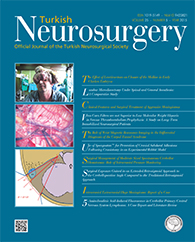Turkish Neurosurgery
2015 , Vol 25 , Num 5
Deep Brain Stimulation of the Rat Subthalamic Nucleus Induced Inhibition of Median Raphe Serotonergic and Dopaminergic Neurotransmission
1Ondokuz Mayıs University, School of Medicine, Department of Neurosurgery, Samsun, Turkey2Maastricht University Medical Center, Departments of Neuroscience and Neurosurgery, Maastricht, Netherlands
3Hasselt University, Department of Morphology, Diepenbeek, Belgium
4University Hospital RWTH Aachen, Department of Neurosurgery, Aachen, Germany DOI : 10.5137/1019-5149.JTN.11230-14.0 AIM: Deep brain stimulation (DBS) of the subthalamic nucleus (STN) relieves motor dysfunction in advanced Parkinson’s disease (PD). However, STN DBS treated patients can experience unpleasant and debilitating psychiatric side effects such as depression and impulsivity. The neural basis of these psychiatric effects has been linked to a dysfunction of 5-hydroxytryptamine (5-HT, serotonin) neurotransmission. STN DBS inhibited activity of 5-HT cell bodies in the dorsal raphe nucleus (DRN). Another important 5-HT source is located in the median raphe nucleus (MRN), which also contains a population of dopamine neurons. The effects of STN DBS on the MRN are unknown. Here, we test the hypothesis that STN DBS reduces 5-HT and dopaminergic function in the MRN, which may contribute to the psychiatric side effects of STN stimulation.
MATERIAL and METHODS: Bilateral STN DBS was applied in a freely moving rat model. Following STN DBS, rats were sacrificed and the brains were processed for c-Fos, 5-HT and tyrosine hydroxylase (TH) immunohistochemistry.
RESULTS: We found that STN DBS significantly lowered c-Fos expression compared to non-stimulated controls indicating reduced neuronal activity. Moreover, the mean optical density values of 5-HT and TH cells in the MRN was significantly lower compared to controls.
CONCLUSION: These results show that STN DBS inhibits 5-HT and dopamine neurotransmission in the MRN.
Keywords : Subthalamic nucleus, Median raphe nucleus, Serotonin, Dopamine, Deep brain stimulation, Parkinson’s disease, Psychiatric disorders




